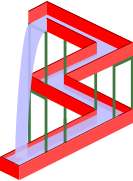- Borromean rings – although conventionally drawn as three linked circles in three-dimensional space, any realization must be non-circular. [1]
- Penrose stairs – created by Oscar Reutersvärd and later independently devised and popularised by Lionel Penrose and his mathematician son Roger Penrose. [2] A variation on the Penrose triangle, it is a two-dimensional depiction of a staircase in which the stairs make four 90-degree turns as they ascend or descend yet form a continuous loop, so that a person could climb them forever and never get any higher.
- An impossible cube—invented by M. C. Escher for Belvedere , a lithograph in which a boy seated at the foot of the building holds an impossible cube [3] [4]
- Penrose triangle (tribar) – first created by the Swedish artist Oscar Reutersvärd in 1934. Roger Penrose independently devised and popularised it in the 1950s, describing it as "impossibility in its purest form".
- Impossible trident (or devil's tuning fork) – also known as a "blivet", this has three cylindrical prongs at one end, which then mysteriously transform into two rectangular prongs at the other end. [5]
- Oscar Reutersvärd's optical illusion (1934)
Explanations

Impossible objects can be unsettling because of our natural desire to interpret 2D drawings as three-dimensional objects. This is why a drawing of a Necker cube would most likely be seen as a cube, rather than "two squares connected with diagonal lines", "a square surrounded by irregular planar figures" or any other planar figure. Looking at different parts of an impossible object makes one reassess the 3D nature of the object, which confuses the mind. [6]
In most cases the impossibility becomes apparent after viewing the figure for a few seconds. However, the initial impression of a 3D object remains even after it has been contradicted. There are also more subtle examples of impossible objects where the impossibility does not become apparent spontaneously and it is necessary to consciously examine the geometry of the implied object to determine that it is impossible.
Roger Penrose wrote about describing and defining impossible objects mathematically using the algebraic topology concept of cohomology. [7] [8]








